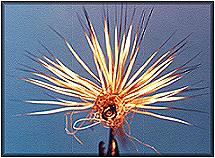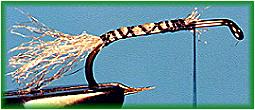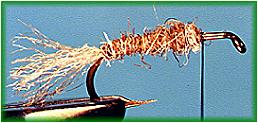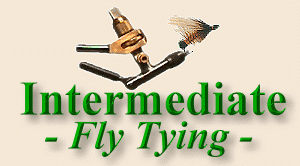
12. Your completed fly should look like this from the front. Notice how
coarse the mule deer hair is? This wing will be more fragile than a wing
created with fine hair.
As you look at this next fly, you're going to say it's almost the same
as the first one. That's correct, except for one small but significant
change; the tail is different. To the human observer this might not be
significant, but to the trout it can make a big difference. In fact, it
might be the difference between catching fish and going home fish-less.
When aquatic insects emerge from their nymphal or pupal shells, they
have their old skin attached for a short time as they dry their wings and
finalize their emergence. While it's attached to the emerging adult,
this skin is referred to as a trailing shuck. By the time the insect is
ready to fly, the shuck has been shed and has drifted away. From below,
the attached shuck is semi-transparent and sparkles in the sun. It's
often the catalyst that triggers a strike from fish looking for a meal
that won't be able to escape.
That's why the Sparkle Dun is significant. The antron or Z-Lon tail
looks like a trailing shuck. When emerging mayflies are on the water,
that tail will often trigger a strike from fish that would shy away from
a comparadun.
To show the difference the hair you choose can make in the finished fly,
I've tied the next fly with a finer, darker deer hair. For the record,
using fine deer hair results in a better looking and stronger wing. But,
if all you have is coarse hair, as you can see, it's possible to tie a
nice fly with that hair too. Although good materials are important to
the creation of durable and well-balanced flies, never let something like
less than ideal materials stop you from tying a fly you want.
I've also shown the other prominent method of tying the wing. There
have been, and will be many discussions about which method of wing
attachment is best. One group says the wing should be attached with the
tips of the hair pointed back so the wing will look more natural if the
dubbing that supports it begins to relax during fishing. The other group
feels it's a stronger wing if it's attached the way I showed you in the
Comparadun. I personally don't think it matters. The important thing is
that the wing is of the proper proportions and is attached securely.
I'll let you decide which method suits you best.
Let's tie another fly.
List of materials: The Sparkle Dun
Hook: Light wire dry fly. Mustad 80000BR or
equivalent. Size 12 to 22.
Thread: 6/0 Gudebrod or equivalent, black or color to match body.
Tail: Z-Lon or antron.
Body: Anglers Choice Llama dubbing.
Any quality dry fly dubbing will also work.
Wing: Deer hair tied fan style. (I'm using fine mule deer hair on
this second fly to show the effect it creates in the wing.)
Tying steps:

1. Tie a tail of Z-Lon or antron fibers as shown.

2. Dub a body to the wing attachment point.
|


















